- Casting a Wide Net
- Boom! Production Audio
- Production Design and Art Department
- That Look of Film
- Lighting for Narrative
- Postproduction: "We're Gonna Need a Montage"
- Sample Project: The Interrogation
- Words to Live by: Terms and Jargon
Postproduction: “We’re Gonna Need a Montage”
In the medium of motion pictures, the most essential part of the process is editing. Think about what it’s like when you watch unedited home videos with your family. It is long, painfully boring, and difficult to see a point in doing so.
Just removing the moments where the camera shakes, the image is out of focus, or nothing important is happening on the screen would improve the viewing experience a lot. Having some music playing underneath would be great too. Actually, having the whole collection of video your aunt shot during a holiday cut down into small bits and fit into one song would make for a memorable and fun video. That video could be called a montage.
The Strategies of Montage
The term montage comes from the French word meaning assembly. Montage describes a sequence that uses a collection of short clips to show a passage of time. This allows a storyteller to show a multitude of related events in a shorter period of time, thus compressing time for the viewer.
This compression of time is what makes the medium of the motion picture so powerful and effective as a method of message delivery. Commercials are a great example of how a message is delivered with a story through compressed time, for instance a limit of 30 seconds.
The most famous example of montage can be found in the film Rocky (1976), where legendary editor Richard Halsey compresses Rocky’s weeks of training into the length of a memorable piece of musical score.
This sequence set the standard for the training montage. Montages are typically named after the type of progression they depict. Another popular montage is the shopping or getting-dressed montage, as seen in Pretty Woman (1990). Yet another is the epiphany montage, where a character recalls moments from throughout the film to come to a major realization, as edited masterfully by John Ottman in The Usual Suspects (1995). Clueless (1995) created a montage that was both a shopping and an epiphany montage.
Making Fast Work
The music video has been credited with the biggest change in proving that a viewing audience can perceive a message through a series of rapidly cut images. MTV (formerly Music Television) premiered in the early 1980s and became at one point the singular platform for the experimentation of a new form of motion picture. Directors who started their careers making music videos and commercials transitioned into feature films and brought their fast-cutting techniques with them.
With directors such as Ridley Scott (Prometheus, 2012), Michael Bay (The Transformers series), David Fincher (The Social Network, 2010), Spike Jonze (Where the Wild Things Are, 2009), Michel Gondry (Be Kind Rewind, 2008), and Gore Verbinski (The Pirates of the Caribbean series) all coming from the fast-paced music video format, it’s no wonder that what we watch today is so much faster-paced than the films we were watching 30 years ago.
A 2011 study by researchers at Cornell University on the change in pace in films over the previous 75 years found that the number of shots in motion pictures has tripled and the average length of each shot has decreased to a third.
Another study, also from Cornell, found that viewers watching a Michael Bay film consumed 65 percent more calories than if they watched a slow-paced talk show. Talk about eye candy!
This increase in the speed of cutting and shortening of shots is obvious in blockbuster action movies, but it has trickled down into an astonishing variety of genres in the world of new media.
Making Short Work
The extent to which media makers have demonstrated how compressed time can be, while still telling an effective story, continues to push beyond the limits of what was thought possible. The comedy film series 5 Second Films took the absurd idea of telling a funny story in five seconds and made a name for themselves doing just that.
Not taking it as a joke, the Vine video-sharing service, starting in 2013, not only challenged the world to tell stories in six seconds but also popularized a new aspect ratio of 1:1 (a perfect square).
The Kuleshov Effect
Soviet film pioneer Lev Kuleshov developed the theory of editing that is the core foundation of the motion picture, which we know as the Kuleshov effect.
The Kuleshov effect is the phenomenon that two images, having no intentional connection or relation to one another, will create new meaning and interpretation simply by being seen sequentially, or juxtaposed. Many filmmakers, including Alfred Hitchcock—who referred to the Kuleshov effect as pure editing—believed that the juxtaposition of shots, more than the composition of any individual shot, was the truest magic of cinema.
The most popular example of Kuleshov’s demonstration of this theory starts with a close-up shot of a man, an actor who stares off-screen with a blank or ambiguous expression. By cutting this shot together with a shot of a bowl of soup, then back to the man, the effect is the audience perceives that the man is hungry (see FIGURE 4.31). The same shot of the man intercut with the shot of a child in a coffin gives the illusion that the man is sad (see FIGURE 4.32). To drive the point home, juxtaposing the same shot of the man with a shot of an attractive woman reclining on a chaise lounge, gives the audience the idea that the man is feeling lustful (see FIGURE 4.33).
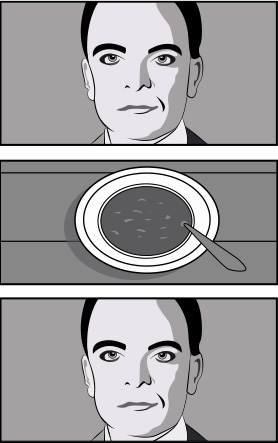
FIGURE 4.31 The Kuleshov effect: hunger
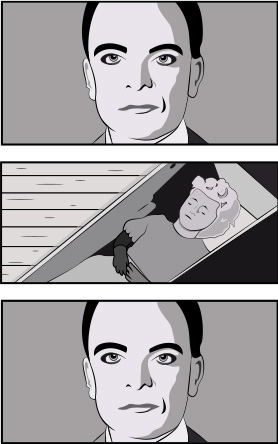
FIGURE 4.32 The Kuleshov effect: sadness
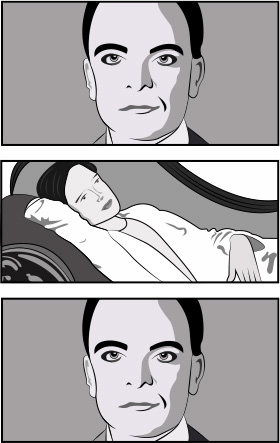
FIGURE 4.33 The Kuleshov effect: lust
Is the man actually feeling any of the suggested emotions? Does it really matter? What matters is that the audience naturally looks for a connection in the images, which means that you as a storyteller have a powerful tool for bypassing your audience’s rationality and reaching them via their subconscious mind. Just remember to use it responsibly.
The Tough Love of Trimming
- “If I had more time, I would have written a shorter letter.”
- —Blaise Pascal
Sometimes you have to hurt the ones you love. In the same way it is said that writing is rewriting, editing is reediting. The workflows for projects in the previous chapters gave no suggestion to do any trimming, or creating new cuts or drafts of your work.
As you were editing those projects, you may have noticed errors that you corrected. Some common errors include jump cuts, flash frames, and repeated action or dialogue when cutting from one shot to another. Assuming you’re past making these rookie mistakes, let’s talk about trimming at a higher level.
The primary reason a project needs trimming is to control its pace or timing. At a basic level, cutting for a specific program time motivates a cut after the assembly stage. A commercial might need to be exactly 30 seconds. A program that has to fit into a half-hour TV slot needs to have a total running time (TRT) of 22 minutes to allow time for commercials. Student film festivals and video contests commonly have running time limits for submissions.
Perhaps you don’t have those limitations. One of the many great things about new media video platforms is that there are virtually no standards for how long a video should be. The problem is that, according to numerous studies, the human attention span is shrinking. Shiny object! Okay, good, we’ve got your attention again. With the popularity of the Skip Ad button and Vine videos, it might be a good idea to spend some time trimming your project.
Before moving forward and sharing some trimming methods, consider a broader definition of the term trimming. The popular definition of the verb trimming is the clipping or removal of small bits to shorten the project. An alternative definition as a noun is decoration or garnish. Trimming a sequence most certainly will include the shortening of segments in your edit, but we will also label the addition or substitution of footage as trimming, such as when adding decoration or garnish.
One more important consideration is to version your sequence or edit. Versioning is the duplication of your edit to keep a backup reference of your edit at a specific point in the workflow.
If your rough cut or assembly is called ProjectName_v1, duplicate the sequence and name the copy ProjectName_v2. You can also add a brief description to the version, such as ProjectName_v1_assembly or ProjectName_v2_directors-cut.
How to Stay Fit and Trim
At the beginning of this section, we mentioned that the definition of trimming is broader than you might think. To understand the various ways to trim your footage, you must become familiar with some terms first.
Because of the variety of methods and technology in picture editing evolving over time, there are numerous ways to describe simple editing concepts. For instance, the juncture between two clips or where a cut occurs is called an edit point. Each side of that juncture can also be called an edit point.
Actually, there are many other terms for that single-frame location. The out-point, end, tail, or last frame of an outgoing clip can be called the A-side of a cut. The in-point, start, head, or first frame of an incoming clip can be called the B-side of a cut (see FIGURE 4.34).
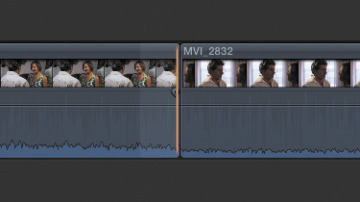
FIGURE 4.34 The two sides of an edit point
Once you get comfortable with the different terms describing an edit point and begin to use them consistently, you can move on to understanding the ways to change those edit points. There are four basic trims that can made to a single clip (see FIGURES 4.35-4.38).
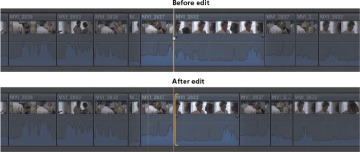
FIGURE 4.35 Shortened at the head
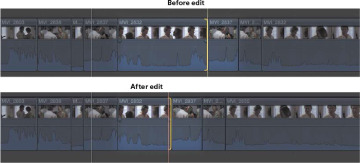
FIGURE 4.36 Shortened at the tail
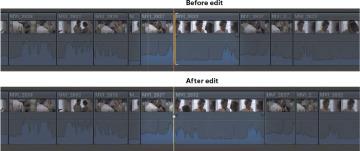
FIGURE 4.37 Lengthened at the head
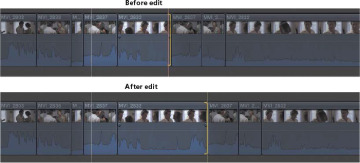
FIGURE 4.38 Lengthened at the tail
At times there will be material in the middle of a clip that you want to remove. In film editing, this was called a lift. In nonlinear editing, a lift, which is performed with the Delete or Backspace key, will leave a gap in your edit. If you’re cutting with a system like Final Cut Pro X that has a magnetic timeline, then deleting a selection or entire clip will not leave a gap. To avoid leaving a gap, you can choose an extract or ripple delete.
Here are two methods to remove, lift, extract, or delete footage from the middle of a clip.
- Select a range, either with a range selection tool or with the I and O keys, and then perform a lift, extract, or deletion.
- If you like a more tangible approach that feels like you’re actually doing something physical, use a blade tool to cut the clip segment into pieces. You can then select pieces to delete, move, or reorder.
Radio Edit
When cutting a dialogue scene, an effective approach to managing its pacing is a technique called a radio edit. To create a radio edit, play back the assembly version of the scene, but turn off the video track first (see FIGURE 4.39). Can’t turn off the video track in your editing software? Try closing your eyes instead. By focusing only on the audio of the scene, you can more easily notice unnecessary pauses and redundancies in the content of the scene.
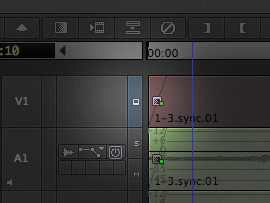
FIGURE 4.39 The Video Track Monitor button in the timeline in Avid Media Composer
You might trim it tighter for a fast-moving scene, or you might find that the pace doesn’t let the audience breathe. Perhaps a line of dialogue doesn’t quite make sense where it was originally intended. Moving some of the lines around in a different order might help you find a different meaning to the scene or just make it weird and incomprehensible. After experimenting, turning the video back on will reveal some issues with the cut, such as continuity errors or jump cuts.
“It’s Time to Split”
Once you’ve completed your radio edit, a trimming technique that will take your edit to professional-polish level is the split edit, also called L-cuts or J-cuts, named because of the shape the clips resemble after the trim is made.
A split edit is made when you need to leave the audio edit in place but transition the video sooner or later than the audio. This is incredibly useful to see reaction shots that could inform the audience of a character’s thoughts.
In a J-cut, the audio transition occurs before the video transition (see FIGURE 4.40). This is a good way to start hearing an off-screen character while holding the picture on the character who has just finished speaking. J-cuts are commonly used when someone is interrupted and we want to see their reactions before cutting to the person who has taken over speaking.
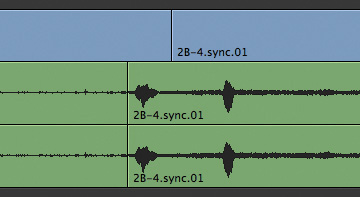
FIGURE 4.40 A J-cut split edit in Avid Media Composer
In an L-cut, the video transition occurs before the audio transition (see FIGURE 4.41). Doing this lets you show a character react to another character as they finish speaking. L-cuts are commonly used to see a character at the moment they process what another character is saying, while waiting their turn to speak.
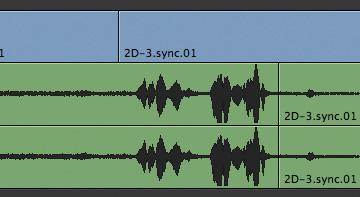
FIGURE 4.41 An L-cut split edit in Avid Media Composer
Not every edit point requires a split edit, but it’s good to experiment so that you don’t leave your sequence going back and forth predictably like a tennis match.